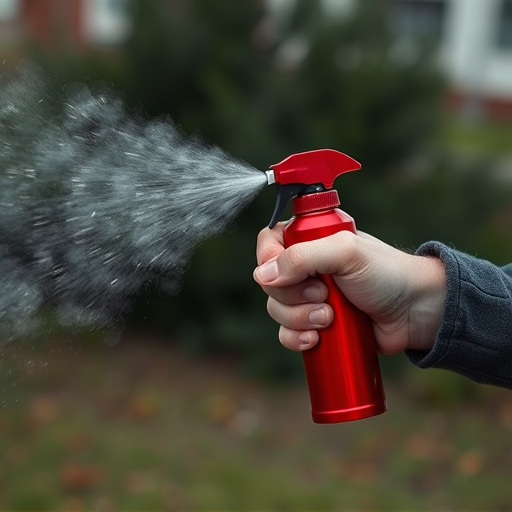Choosing the best pepper spray delivery methods enhances personal safety and effectiveness in diverse scenarios. Handheld devices offer direct control for close combat, while aerosol systems disperse mist over larger areas. Extended-range options provide tactical advantages in crowded places. Training is essential for accurate deployment at various distances. Understanding local laws regarding pepper spray ownership and usage is crucial for legal compliance and informed self-defense decisions.
“Uncover the power of pepper spray as a personal defense mechanism with our in-depth guide on the best delivery methods. From the chemistry behind its effectiveness to legal considerations, we explore what makes pepper spray a viable self-defense option.
Learn about the science of capsaicin, the active ingredient, and how it disrupts sensory perception. Discover the various delivery systems—from direct application to aerosol—and understand their pros and cons. Gain insights into range, accuracy, and safety tips, ensuring you’re prepared for any scenario.”
- Understanding Pepper Spray Chemistry
- Effective Delivery Systems Explored
- Direct vs. Aerosol Application
- Range and Accuracy Considerations
- Legal Implications and Safety Tips
Understanding Pepper Spray Chemistry
Pepper spray, a powerful deterrent and self-defense mechanism, operates on the principle of disrupting an attacker’s sensory perception. Understanding its chemistry is crucial to harnessing its potential effectively. The active ingredient in pepper spray is capsaicin, a natural compound derived from chili peppers. When deployed, this compound irritates the eyes, nose, and throat, causing temporary blindness, coughing, and difficulty breathing. This sensation can last for several minutes, providing users with valuable time to escape or defend themselves.
The best pepper spray delivery methods ensure direct contact with the attacker’s face. This includes aerosols, sprays designed for hand-held use, and even advanced devices that shoot a stream of pepper spray from a distance. The choice of delivery method depends on personal preference, training, and the specific situation. Each method has its advantages; for instance, handheld sprays offer precision and control, while aerosol cans provide a broader reach. Understanding the chemistry behind pepper spray and selecting the optimal delivery method can significantly enhance personal safety and deter potential threats.
Effective Delivery Systems Explored
The effectiveness of a pepper spray deterrent greatly relies on its delivery system. Among the best pepper spray delivery methods are those that ensure precise and swift application, minimizing the risk of harm to bystanders while maximizing impact on the target. Handheld spray devices, for instance, offer direct control but may be less reliable in crowded areas or during high-stress situations due to potential misaiming.
On the other hand, advanced systems like tactical vest-mounted sprayers and long-range launchers provide more consistent and controlled deployment, making them ideal for law enforcement and security personnel. These best pepper spray delivery methods are designed to deliver a powerful dose of capsaicin from a safe distance, temporarily disabling suspects without causing permanent harm. This strategic approach enhances safety and effectiveness in various scenarios, from public events to high-risk security operations.
Direct vs. Aerosol Application
When considering pepper spray as a deterrent for self-defense, understanding the delivery method is key. There are two primary application types: direct and aerosol. Direct application involves spraying the offender directly in the face, eyes, or nose, aiming to neutralize them momentarily. This method requires close proximity and accuracy, making it suitable for situations where you need immediate control over an attacker. On the other hand, aerosol delivery systems disperse a fine mist of pepper spray over a larger area. These are typically carried in canisters that can be fired from a distance, offering more versatility in self-defense scenarios, especially in public spaces or crowded areas.
The best pepper spray delivery method depends on individual preferences and potential threats. For close-quarters combat, direct application provides swift and targeted protection. However, for outdoor activities or situations where keeping a safe distance is crucial, aerosol spray offers a more effective long-range deterrent. Many experts recommend training in both techniques to be prepared for various self-defense scenarios.
Range and Accuracy Considerations
The effectiveness of pepper spray as a deterrent depends heavily on the delivery method and the range at which it can be deployed. When discussing the best pepper spray delivery methods, understanding range and accuracy is paramount. Handheld pepper sprays offer a direct line-of-sight approach, allowing users to target specific aggressors within a relatively close range of approximately 2–3 meters (6–10 feet). This method requires clear visibility and quick reflexes to aim accurately.
On the other hand, spray canisters attached to stun batons or body armor provide a longer reach, usually up to 4–5 meters (13–16 feet), making them suitable for tactical situations. These extended-range options are particularly useful in crowded areas where visibility might be limited. However, achieving accurate deployment becomes more challenging with increased distance, emphasizing the importance of proper training and practice for optimal use.
Legal Implications and Safety Tips
When utilizing pepper spray as a deterrent or for self-defense, it’s crucial to understand the legal implications in your region. Different areas have varying laws regarding who can possess and use pepper spray, with restrictions often based on age, license requirements, and permitted use scenarios. Knowing these regulations is essential to avoid legal consequences.
Safety is paramount when choosing a pepper spray deterrent. Opting for the best pepper spray delivery methods ensures maximum effectiveness while minimizing risks. Using high-quality products from reputable manufacturers guarantees potency and reliability. Always store pepper spray securely, out of reach of children and unauthorized individuals, and familiarize yourself with safe handling practices to prevent accidental discharge.
Pepper spray has established itself as a powerful personal defense mechanism, with various delivery systems offering unique advantages. By understanding the chemistry behind pepper spray and exploring optimal application methods such as direct vs. aerosol, we can make informed choices to enhance our safety. The best pepper spray delivery methods prioritize accuracy and range while adhering to legal guidelines. Armed with knowledge of these factors, individuals can choose the most effective solution for their protection needs, ensuring peace of mind in potentially dangerous situations.
